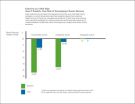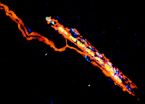(Press-News.org) PASADENA, Calif., December 18, 2014 -- Self-reported moderate to vigorous exercise was associated with lower blood pressure and blood glucose levels in a Kaiser Permanente study published in the journal Preventing Chronic Disease. Data collected from Kaiser Permanente's Exercise as a Vital Sign (EVS) program, in which medical office staff asks patients about their exercise habits at every health care visit, revealed associations between moderate to vigorous exercise and improved measures of cardiometabolic health for both men and women. Few previous studies have examined associations between self-reported physical activity and cardiometabolic risk factors within a health care setting.
The study examined the electronic health records of 622,897 Kaiser Permanente Southern California adult members who were generally healthy and had at least three outpatient visits during the two-year study period. As part of the EVS program, patients were asked how many days per week they engage in moderate to strenuous exercise (like a brisk walk) and how many minutes they engage in exercise at this level. The study authors categorized patients as "regularly active" if they reported 150 minutes of exercise per week or more, "irregularly active" if they reported any exercise but less than 150 minutes per week, and "inactive" if they reported no exercise. Among those excluded in the study were people with major health issues and individuals taking medications to lower blood pressure or control glucose.
"Although this study was cross-sectional and we cannot presume causality between the level of physical activity and health status based on these data, combining our findings with results from intervention studies suggest that exercise can play an integral part in moderating/lowering blood sugar and blood pressure, and ultimately a patient's cardiometabolic health," said Deborah Rohm Young, PhD, of the Kaiser Permanente Department of Research & Evaluation in Pasadena, California.
The study found that women who were consistently and even irregularly active had lower systolic and diastolic blood pressure compared with those who were inactive. Men had lower diastolic blood pressure but there was no association with their systolic blood pressure. The findings also showed that consistently and irregularly active male and female patients had fasting glucose levels lower than the consistently inactive patients. Consistently active and irregularly active women had a greater magnitude of difference for cardiometabolic variables compared with similarly active men.
The EVS program also encourages Kaiser Permanente physicians and other health care professionals to recommend more exercise to those who report little or no regular activity in an average week. Physicians recommend "moderate to vigorous" exercise (such as a brisk walk) to patients who report being inactive.
"If health care providers would routinely assess the physical activity of their patients and refer the physically inactive patients to exercise programs, it may reduce the incidence of future chronic diseases," said Young.
Kaiser Permanente can deliver transformational health research in part because it has the largest private electronic health system in the world. The organization's integrated model and electronic health record system securely connect approximately 9.5 million people, 618 medical offices, and 38 hospitals, linking patients with their health care teams, their personal health information, and the latest medical knowledge. It also connects Kaiser Permanente's epidemiological researchers to one of the most extensive collections of longitudinal medical data available, facilitating studies and important medical discoveries that shape the future of health and care delivery for patients and the medical community.
This paper is part of Kaiser Permanente's ongoing efforts to encourage physical activity among its members and improve health care quality and safety. Kaiser Permanente has published numerous studies about the benefits of Exercise as a Vital Sign, which it launched in 2012. In April, a Kaiser Permanente study published in the Annals of the American Thoracic Society found that patients with chronic obstructive pulmonary disease who had moderate to vigorous physical exercise had a lower risk of hospital readmission within 30 days. In December 2013, a Kaiser Permanente study published in the Journal of General Internal Medicine found that asking patients about their exercise habits was associated with weight loss in overweight patients and improved glucose control for patients with diabetes.
INFORMATION:
This work was supported by the Southern California Permanente Medical Group. The authors have no conflicts of interest to declare.
Other authors of the paper include: Karen J. Coleman, PhD, Eunis Ngor, MS, Kristi Reynolds, PhD, Margo Sidell, PhD, of the Kaiser Permanente Southern California Department of Research & Evaluation, and Robert E. Sallis, MD, of the Kaiser Permanente Fontana Medical Center.
About the Kaiser Permanente Southern California Department of Research & Evaluation
The Department of Research & Evaluation conducts high-quality, innovative research into disease etiology, prevention, treatment and care delivery. Investigators conduct epidemiology, health sciences and behavioral research as well as clinical trials. Areas of interest include diabetes and obesity, cancer, HIV/AIDS, cardiovascular disease, aging and cognition, pregnancy outcomes, women's and children's health, quality and safety, and pharmacoepidemiology. Located in Pasadena, California, the department focuses on translating research to practice quickly to benefit the health and lives of Kaiser Permanente Southern California members and the general population. Visit kp.org/research.
About Kaiser Permanente
Kaiser Permanente is committed to helping shape the future of health care. We are recognized as one of America's leading health care providers and not-for-profit health plans. Founded in 1945, our mission is to provide high-quality, affordable health care services and to improve the health of our members and the communities we serve. We currently serve approximately 9.5 million members in eight states and the District of Columbia. Care for members and patients is focused on their total health and guided by their personal physicians, specialists and team of caregivers. Our expert and caring medical teams are empowered and supported by industry-leading technology advances and tools for health promotion, disease prevention, state-of-the-art care delivery and world-class chronic disease management. Kaiser Permanente is dedicated to care innovations, clinical research, health education and the support of community health. For more information, go to: kp.org/share.
The part of the brain that tells us the direction to travel when we navigate has been identified by UCL scientists, and the strength of its signal predicts how well people can navigate.
It has long been known that some people are better at navigating than others, but until now it has been unclear why. The latest study, funded by the Wellcome Trust and published in Current Biology, shows that the strength and reliability of 'homing signals' in the human brain vary among people and can predict navigational ability.
In order to successfully navigate to a destination, you ...
VIDEO:
Research from Univ. of Iowa and Russian scientists show crows are capable of executive-level thinking.
Click here for more information.
Crows have long been heralded for their high intelligence - they can remember faces, use tools and communicate in sophisticated ways.
But a newly published study finds crows also have the brain power to solve higher-order, relational-matching tasks, and they can do so spontaneously. That means crows join humans, apes and monkeys in exhibiting ...
TORONTO -- Very small segments of genes called "microexons" influence how proteins interact with each other in the nervous system, scientists at the University of Toronto have found, opening up a new line of research into the cause of autism.
The researchers found that microexons are used in neurons by alternative splicing, a process in which a single gene can produce many different proteins. Microexons are pasted -- or spliced -- into gene messengers (mRNAs) to generate forms of proteins that the nervous system needs to function properly. Misregulation of this process, ...
RESEARCHERS have discovered the unique genetic paths that the childhood brain tumour medulloblastoma follows when the disease comes back, according to research* published in Cancer Cell today (Thursday).
The study - funded by Cancer Research UK, Action Medical Research and others** - shows that taking an extra tumour sample at recurrence, when there are no effective therapies, could identify subsets of patients that might be treatable with existing drugs that target the genetic faults.
The scientists, based at Newcastle University and The Institute of Cancer Research ...
There are two main families of bacteria : those that are surrounded by a single membrane (or one outer wall) and those that are surrounded by two membranes (or two outer walls). The team of Jean-François Collet, professor at the de Duve Institute at UCL, looked at this second type of bacteria.
For a bacterium to survive, it has to keep its two outer walls intact. If one of these walls is damaged, the bacterium dies. So it was vital for the UCL researchers to analyse the protection mechanisms of these bacterial "walls' (to find their weak spot), so as to be able to ...
This latest research by Joshua Brickman and his research team from Danish Stem Cell Center (Danstem) at the University of Copenhagen specifically found that inhibiting or blocking stem cells ability to make a specific decision, leads to better cell growth and could lead to defined ways to differentiate stem cells.
This research is the first comprehensive analysis of a pathway important for stem and cancer cell decisions known as Erk. As a result this work could contain clues to cancer treatment as well as helping to establish a platform to make stem cell treatments for ...
After an incomplete spinal cord injury, the body can partially recover basic motor function. So-called muscle spindles and associated sensory circuits back to the spinal cord promote the establishment of novel neuronal connections after injury. This circuit-level mechanism behind the process of motor recovery was elucidated by Prof. Silvia Arber's research group at the Biozentrum, University of Basel and the Friedrich Miescher Institute for Biomedical Research. Their findings may contribute to designing novel strategies for treatment after spinal cord injuries and have ...
Walter and Eliza Hall Institute researchers have for the first time revealed how dying cells are hidden from the immune 'police' that patrol the body.
The research answers a decades-old mystery about the death of cells, which in some situations can alert the immune system to potential danger, but in other circumstances occurs 'silently', unnoticed by immune cells.
Silent cell death, or apoptosis, is a controlled way for the body to eliminate cells that may be damaged, old, or surplus to the body's requirements, without causing collateral damage. This 'normal' cell death ...
This news release is available in Spanish. The genome is the cell's book of instructions. All the cells in our body contain the same genomic information but each of them "reads" the gene fragments that interest them in order to carry out their function. So, neurones, hepatocytes and cardiac cells are different although their genome is the same. In order to achieve this huge variety of functions from the same genome, the cells employ a mechanism known as alternative splicing. This enables them to combine several fragments - known as exons - from the same genes in order ...
Mountain View, Calif. - December 18, 2014 - 23andMe, Inc., the leading personal genetics company, today announced the publication of a study that pinpoints fine-scale differences in genetic ancestry of individuals from across the United States.
Since immigrants first arrived more than four hundred years ago, the United States has served as a meeting place for peoples from different continents. This study illuminates how American history and the ongoing mixing of peoples with African, European, and American origins can be seen in our DNA.
"The relationship between genomics ...



